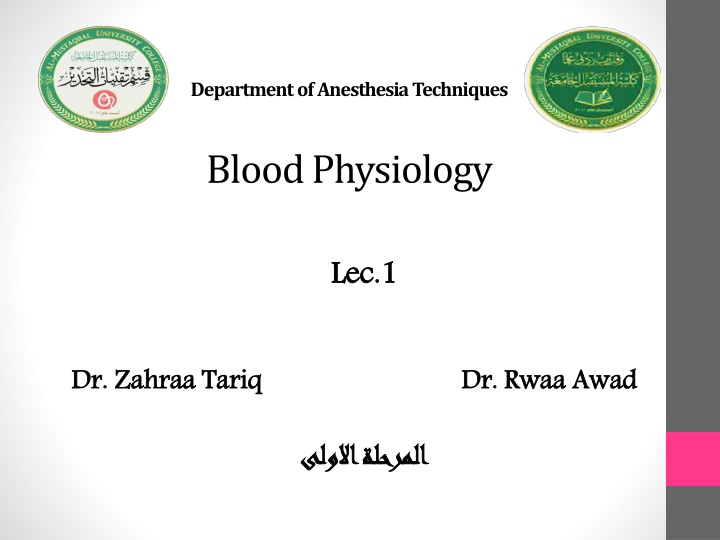
Blood Physiology
Explore the fascinating world of blood physiology, including its composition, functions, and significance in maintaining overall health. Learn about the cellular and non-cellular elements of blood, the role of plasma and serum, as well as the vital functions of red blood cells. Discover insights into anemia and its different types, shedding light on hemoglobin deficiency issues.
Download Presentation

Please find below an Image/Link to download the presentation.
The content on the website is provided AS IS for your information and personal use only. It may not be sold, licensed, or shared on other websites without obtaining consent from the author. If you encounter any issues during the download, it is possible that the publisher has removed the file from their server.
You are allowed to download the files provided on this website for personal or commercial use, subject to the condition that they are used lawfully. All files are the property of their respective owners.
The content on the website is provided AS IS for your information and personal use only. It may not be sold, licensed, or shared on other websites without obtaining consent from the author.
E N D
Presentation Transcript
DepartmentofAnesthesiaTechniques Blood Physiology Lec. Lec.1 1 Dr. Dr. Zahraa Zahraa Tariq Tariq Dr. Dr. Rwaa Rwaa Awad Awad
Blood is a special type of fluid connective tissue that is composed of 8% of the body mass. Its properties are: Color: bright red in artery & dark red in veins. Ph: slightly alkaline Ph(7.35-7.45). Viscosity: 3-4 times more viscos than water. Volume: about 5-6 liter.
Blood Consist of: A. Cellular Elements (45%) that includes: 1) Red Blood Cells (Erythrocyte). 2) White Blood Cells (Leukocyte). 3) Platelets (Thrombocyte). B. Non-cellular elements that include: Plasma (55%)
Functions of Blood 1. Transport O2 from lungs to body cells and CO2 from body cells to lungs. 2. Transport Nutrients from GIT to body cells. 3. Regulate body temperature and Ph. 4. Platelets and proteins help to repair damaged blood vessels. 5. WBC protect against disease by phagocytosis.
Plasma & Serum Plasma is the liquid part of blood made up of 93% water, 7% proteins, and other solutes like glucose , fatty acid Plasma is all the components of blood, minus the cells. The plasma proteins are albumin, globulins, clotting proteins (prothrombin & fibrinogen)and other proteins (enzymes and hormones). Blood serum is plasma without clotting proteins (prothrombin and fibrinogen).
Cellular Elements of Blood Erythrocytes (RBCs) The most common type of blood cell ,which are small biconcave disc-shaped cells that arise from the bone marrow and they do mitochondria. not have a nucleus or Its containing hemoglobin(Hb) molecules which is iron containing biomolecule that can bind oxygen and it responsible for the red color of blood. The whole blood of men contains about 15 gm/dl of Hb , whereas , for women about 14 gm/dl.
Function of RBCs : The hemoglobin within the RBCs transport O2 from lung to the tissues and CO2 from tissues to the lung.
Anemia Anemia means deficiency of hemoglobin in the blood, which can be caused by either few red blood cells or little hemoglobin in the cells. Types ofAnemia: a) Iron deficiency anemia. b) Megaloblastic Anemia that includes: 1. Folic Acid Deficiency Anemia(low intake of folic acid which is necessary for DNA formation and maturation of RBCs. 2. B12 Deficiency Anemia (B12 is necessary for DNA formation of RBCs)
C. Membrane Defects anemia as in hereditary spherocytosis. D. Hemolytic anemia e.g :autoimmune Hemolytic anemia, E. Hemoglobinopathies e.g Thalassemia and sickle cell anemia. F. Aplastic Anemia (bone marrow failure). G. Blood Loss Anemia after rapid hemorrhage.
Effect of Anemia on Circulation: 1. Decrease the viscosity of blood. 2. Increase the amount of work needed by the heart. 3. During exercise, the oxygenation of the tissues will be reduced.






















